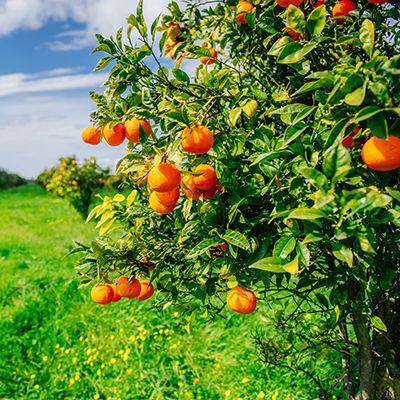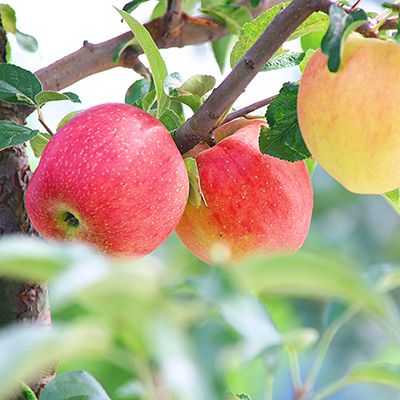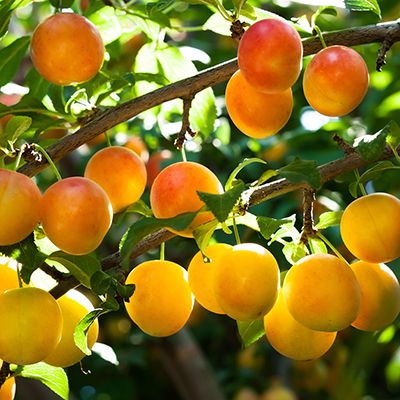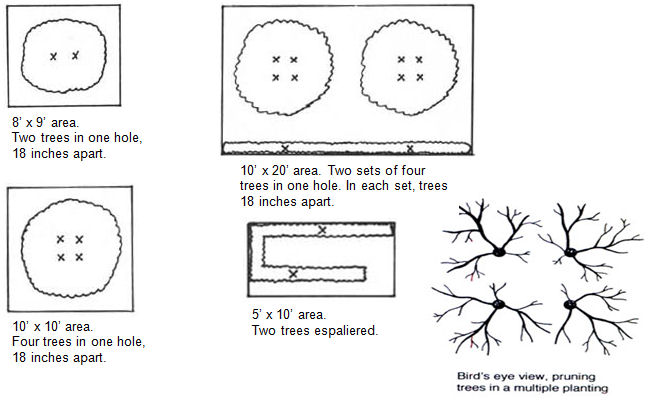


Fruit Trees
General Information
Home orcharding has become increasingly popular as people seek to improve their health with homegrown fruit, save money at the supermarket and enjoy themselves growing their own food. Ultimately, everyone would agree that homegrown fruit is infinitely tastier! To grow your own fruit, you must first ensure that your allotted location can meet the tree’s basic requirements, and then commit some effort to fulfill its specific pruning, thinning and spraying needs. This Care Guide will cover fruit tree basics; please see our individual Care Guides for specific information.
Light
Fruit trees will perform best with at least 6 hours of direct sunlight a day, preferable more.
Water
First year trees should be watered on a weekly basis. Building a basin around the tree at planting will facilitate flood irrigation, a method of watering that decreases the incidence of certain fungal problems in many fruit trees. This basin should be extended to the drip line as your tree grows. As the tree matures, the frequency of watering will lessen. A mature tree, one that is 6 years old or older, should only need water once every 3 to 4 weeks by flooding that basin. If you have multiple fruit trees in the same area, you can create trenches between the trees and water in the same manner. It is important to fill the basin several inches with water to ensure deep watering. If you use drip irrigation, we recommend placing the hosing along the drip line of the tree, with emitters at 18 inch intervals. Again, as the tree grows, this system will need to be adjusted according to the tree’s drip line.
Fertilizing
For best results, use Master Nursery Fruit Tree & Vine Food three times during the year: once in early spring when the flower buds break, once in early summer around Memorial Day and once in the fall around Labor Day. If you prefer organic fertilizers, try Gardner & Bloome Citrus & Fruit Tree Fertilizer and apply about 2 weeks earlier. Always apply fertilizer to moist soil and water thoroughly after application. Supplement organic fertilizers with Iron Sulfate to prevent chlorosis.
Spraying
Dormant season sprays kill insects in their various overwintering stages and help prevent disease during the upcoming growing season. Some fruit trees require spraying during the growing season as well to minimize insect or disease problems. The most efficient way to spray your trees is by using a tank sprayer. We have different sizes of Master Nursery Pest Fighter Sprayers to choose from.
For dormant sprays, we typically recommend Fixed Copper which is a broad spectrum fungicide mixed with Master Nursery Pest-Fighter Year-Round Spray Oil, a paraffin-based product that smothers insects in the adult, larval or egg stages. It is imperative to apply these sprays when there is no chance of rain for the next 24 hours.
During the growing season you may need to spray for fungal problems associated with blossom or fruit set and/or insect problems. For growing season insect problems, we generally recommend broad spectrum insecticides, such as Sevin or Malathion. Liqui-Cop or Fung-onil will be recommended for fungus or bacterial problems. Cultural and environmental conditions can contribute to insect or fungal problems. On our individual fruit tree care guides, you will find strategies in addition to spraying for mediating problems.
Please see our individual fruit tree care guides for specific recommendations before purchasing any fungicides or insecticides. If you have any questions about possible problems, please ask one of our nursery staff.
Planting
When planting bare root trees, dig a hole about 3 feet in diameter and as deep as the longest root. When planting container-grown trees, dig a hole at least 2 times the diameter of the container, and no deeper than the depth of the container. After mixing Master Nursery Master Start into the bottom of the hole, backfill with Master Nursery Gold Rush or Master Nursery Bumper Crop at a one-third ratio with your native soil. Water in well. Be sure that the graft union of the tree remains 4 to 6 inches above the soil level; finish planting by building a berm that is equal to the drip line of the tree.
To maximize fruit production in limited space, consider high-density planting, a method in which several fruit trees are planted in one hole. In this way, you can plant trees and their cross-pollenizers or trees with different ripening periods.
Pruning
Dormant season pruning can begin in late December and continue through February. See our Fruit Tree Pruning Care Guide to identify fruiting wood. If you’re still unsure, you can wait to prune when the tree is in flower. All deciduous fruit trees can be pruned when dormant, except for apricots, which should be pruned in August or September (or after harvest). Also consider summer pruning. Summer pruning helps control growth, enhances light and air penetration into the canopy and encourages secondary branching on long whips. If you utilize high-density planting methods or wish to keep trees small, summer pruning is paramount.
EXAMPLES OF HIGH DENSITY PLANTING:
